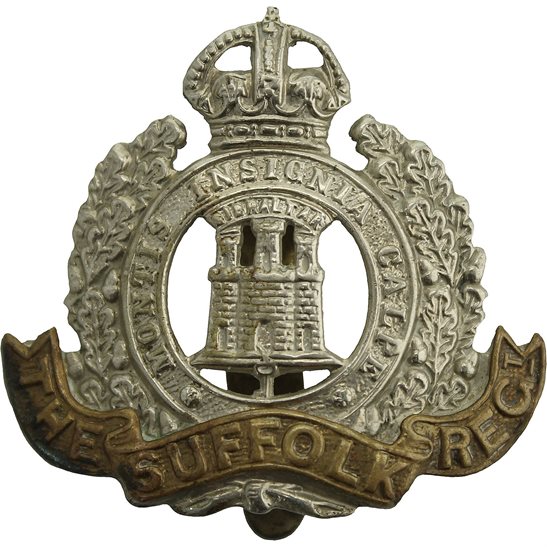Cap badge of the Suffolk Regiment
Frederick, the third son of Isaac and Mary Ann, was born on 21st February 1893. In 1911, he worked as a jobbing gardener in and around Melton and, on 2nd January 1912, he enlisted in the Suffolk Regiment Special Reserve. For Frederick and the other men in the regiment, this meant spending three months undergoing intensive training before returning to civilian life. They would then continue to attend training camps during the year and, unlike members of the territorial force, they could be called up at any time to serve in the regular army if required.
When war was declared on 4th August 1914, Frederick was mobilised and went immediately to the Suffolk Regiment Depot in Bury St Edmunds to await his posting. He was to join the 1st Battalion, Suffolk Regiment who had been recalled from a posting in Sudan and had disembarked in Liverpool on 23rd October.
On 17th November, the 1st Battalion arrived at the Suffolk Regiment’s battle station in Felixstowe, where Frederick joined them. Shortly after, they would travel to Hursley Park, near Winchester, to prepare for their posting to France. This could not come soon enough for the 1st Suffolks, who had spent their time at Hursley Park pitching tents and setting up camps, in wet and muddy conditions, for the other battalions in their division.
Mobilisation to France began on 16th January 1915, when the battalion broke camp in Winchester and marched to Southampton, ready to embark. The battalion boarded the SS Mount Temple the same evening and set sail for France – as there were no destroyers available to escort the Mount Temple, it was forced to moor overnight just offshore from the Isle of Wight. On the 18th, Frederick and the 1st Suffolks disembarked at Le Havre and boarded trains bound for Ypres in Belgium.
Before being a troopship during the war, SS Mount Temple was one of the first ships to respond to the Titanic's distress signals in April 1912.
On 5th February, Frederick and the 1st Suffolks went to the front line for the first time, taking over trenches between the Hill 60 and the Ypres- Comines canal from the 2nd Cheshire Regiment. The battalion remained on the front line until the 11th February in dreadful conditions, with much of the trench system flooded. After only two days in billets, the battalion was sent back to the front line in support of their brigade as the German army had succeeded in breaking through their lines.
The 1st Suffolk's orders were to go into the reserve trenches behind the battle line. These turned out to be either ditches full of water or small banks that provided minimal cover, open to enfilade fire from the enemy. The next day, they were to relieve the Buffs (Royal East Kent Regiment) who were on the front line and hold the position until the following morning when they were to fall back to a new trench system behind them. However, the majority of the Buff's trench was in German hands and fierce fighting quickly broke out. Most of one company of the 1st Suffolks were either killed, wounded or missing, with the others all taken prisoner by dawn the following morning. The rest of the battalion continued to hold their position, attempting to regain the trench from the enemy until they were relieved on 18th February. Many of the men were severely debilitated having stood knee deep in icy water for two days. They needed help getting out of the trenches and during the march back to billets. This action had little publicity and barely a mention in the official histories, despite the 1st Suffolks sustaining over three hundred casualties, of which Frederick was one. He was returned home for treatment, but due to his wounds, he would not be fit enough to rejoin his battalion. On 26th July 1915, he was discharged from the army.
For his war service, Frederick received the 1914-15 Star, the British War and Victory Medals and the Silver War Badge. In 1916, Frederick married Daisy Ethel Cooper in Edmonton, London. By 1939, he was working as a postman and living with his family in Ilford, Essex.
